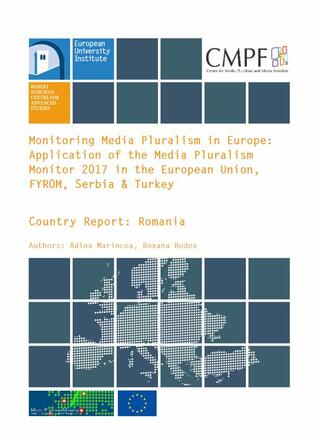
The MPM 2017 analyses the risks to media pluralism in four main thematic areas, encompassing respectively basic protection, market plurality, political independence, and social inclusiveness. These areas are considered to capture the main range of risk for media pluralism and media freedom, considering that they are respectively divided in 20 indicators. A scale from 0 to 100% is used to illustrate the results for each domain and indicator. Scores between 0-33% are considered low risk, whereas scores of 34-66% display a medium risk and rates between 67-100% express high risk. Romania, in addition to being the fastest-growing economy in the European Union, sees a reinforcement of historic problems in the media that interferes in future developments.
In 2017, the Market plurality area turned out to pose the biggest challenges, all indicators being evaluated at high risk. The highest risk concerns the "viability of the media market” (at 83%). This is a result of the fact that Romanian mass media rely almost entirely on advertising revenue that is very unequally distributed across media channels. While TV gets most of the ad revenue (65%), in the last year there has been an increase in online advertising, although not enough to cover the financial needs of the market. As a consequence of low viability, the media market becomes vulnerable to external influences and dependent on financial backers, often with a political or commercial agenda. This is why the report finds high risks of Commercial and owner influence over editorial content (79%), a low Transparency of media ownership (75%), and high Media and cross-media ownership concentration (72% and 67% risk). The report also highlights the fact that in MPM 2016 the Media viability and Transparency of media ownership subindicators were assessed as medium and low risk.
Furthermore, the legal and de-facto context discourages transparency of ownership, given the fact that companies are obliged to disclose their ownership information to public authorities only, and only to some extent. “Legal loopholes” allow the real owners to remain hidden in many cases. Another factor increasing the lack of transparency is the lack of data about the revenues of different media organisations, which also impacts the possibility to define correctly the concentration of the media market (72% and 67% for Cross-media concentration – both at medium risk, according to the report).
Market plurality is not the only area to present a high risk in the indicators. "Social inclusiveness" also presents some inadequacies: different groups in society experience difficulties to access media as a result of broader social exclusion. The highest risks are in the ranges of access to media for "Minorities" (75%), for people with "Disabilities" (67%), and "Media literacy" (71%). Women have overall better access to media (63%) than minorities, but challenges remain.
A third area of concern is "Political independence", assessed at 63% - medium risk. High risk is spotted in "Independence of PSM governance and funding" (92%), "Risks to the Political independence of media" (81%), and "Editorial autonomy" (81%). 2017 witnessed more visible degradation, polarisation, and politicisation of the mainstream media, particularly regarding the anti-government protests that took place in the spring, which were subject to media deviations. During 2017, frequent changes of PSM management interfered with a better strategic, performance-oriented management. Furthermore, the lack of protection for the political independence of PSM services left institutions exposed to external influence (such as the considerable involvement of the state budget in the funding of PSM sectors).
Within the "Basic protection" area, the main concerns involve the "Protection of the right to information" (50%) and the "Universal reach of traditional media and access to the Internet" (50%), both at medium risk and threatening the freedom of expression and the right to information.
The only two indicators that score low risk for media pluralism in Romania are the "Independence and effectiveness of media authority" (23%) and the "Media and the democratic electoral process" (21%), although they raise some concerns over the absence of production and implementation of legal frameworks referring to these areas.
Finally, the conclusions of the report draw the attention to some legislative and regulatory factors that could significantly confine the dangers to pluralism in Romanian media and that could go under reforms during the next years.
The content of this article can be used according to the terms of Creative Commons: Attribution-NonCommercial 4.0 International (CC BY-NC 4.0) . To do so use the the wording "this article was originally published on the Resource Centre on Media Freedom in Europe" including a direct active link to the original article page.

